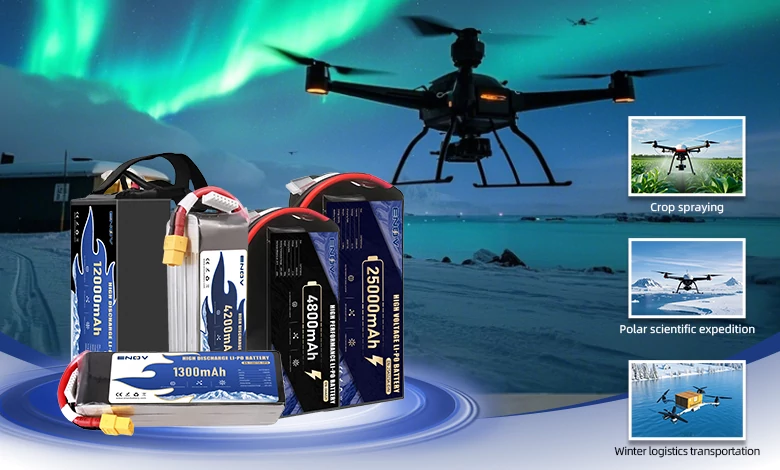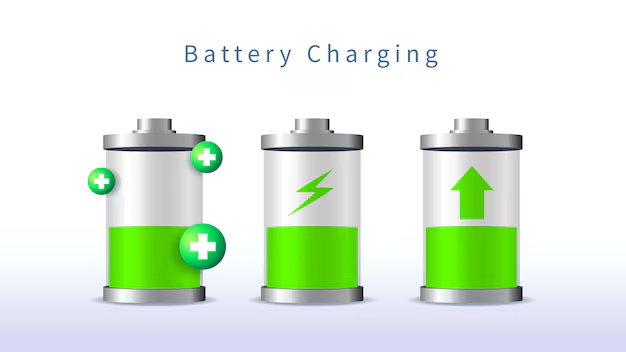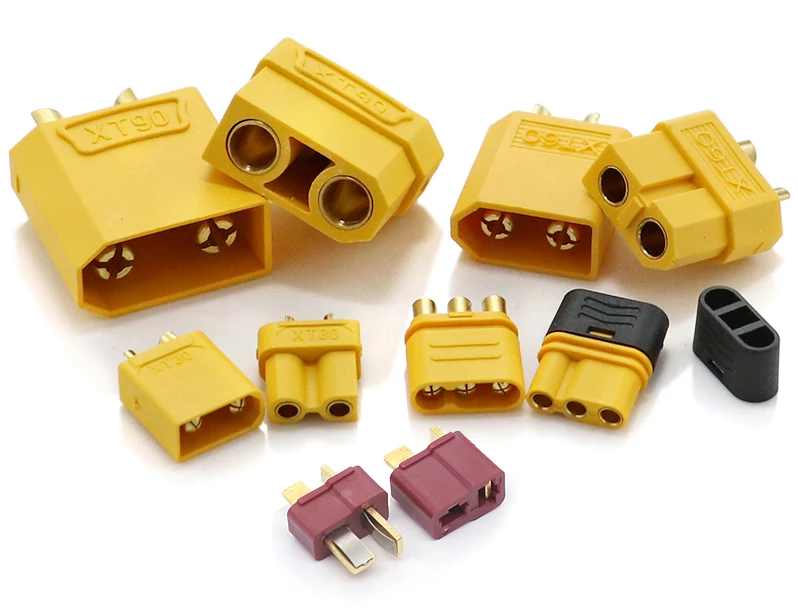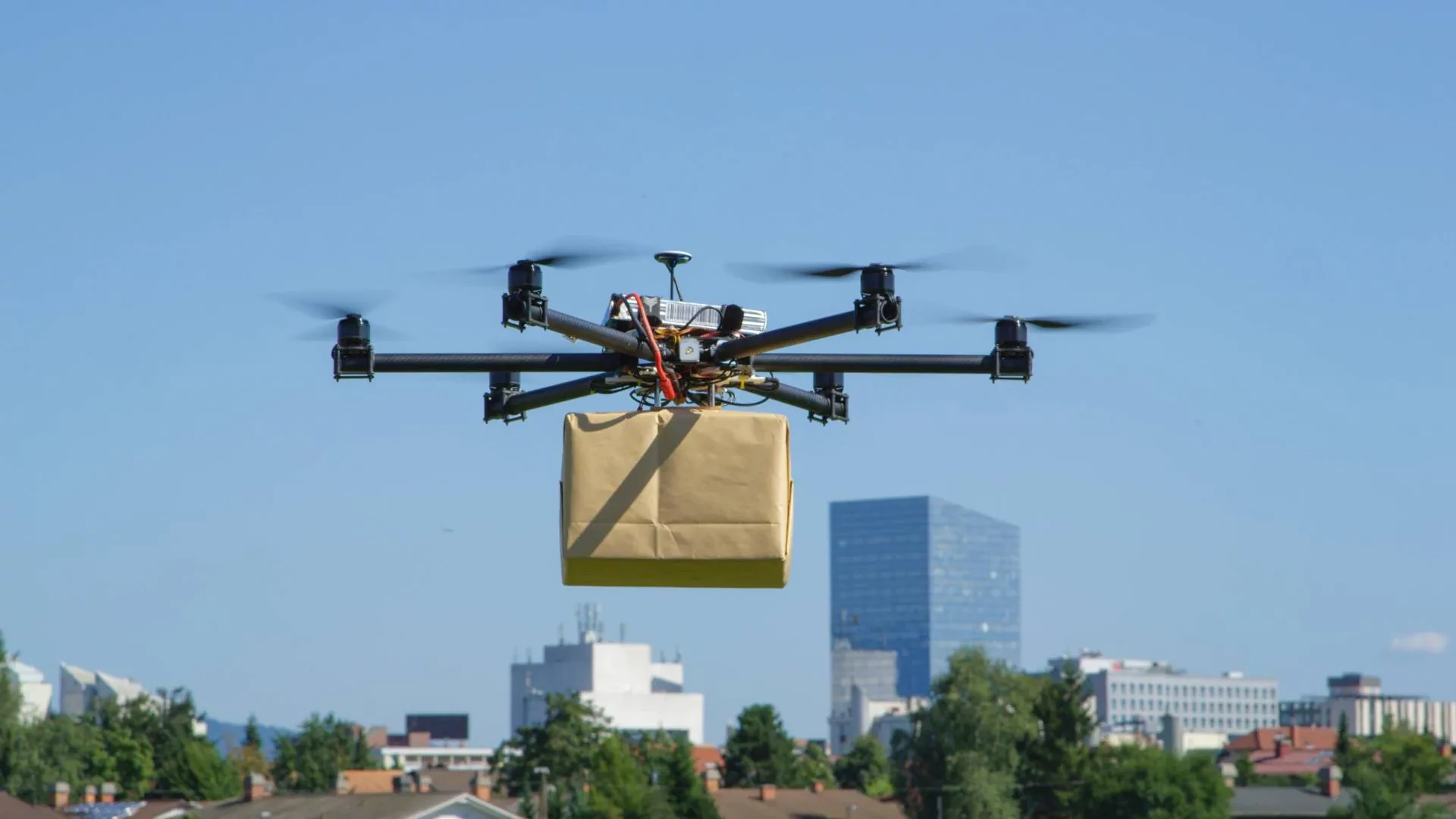Lithium-Ion Batteries

ENOV High-Energy drone batteries power industrial and commercial drones. Delivering 220–320 Wh/kg energy density, they enable long flight times (30+ mins) and support fast charging (2C). Perfect for aerial photography, surveillance, and delivery drones.
1. Core Definition
Lithium-ion batteries are a highly representative rechargeable category within the lithium battery family. Their core design cleverly avoids the issue of metallic lithium dendrite formation. The energy conversion process relies on the migration of lithium ions between the positive and negative electrodes, with no direct participation of metallic lithium in the reaction throughout the process. Since Sony first commercialized them in 1991, lithium-ion batteries, boasting prominent advantages such as high energy density, long cycle life, and light weight, have become a core energy technology in the fields of consumer electronics, electric vehicles, and energy storage systems.
2. Structural Composition and Working Principle
(1) Core Structure
The structure of a lithium-ion battery is sophisticated, with each component performing its dedicated function to jointly ensure the stable operation of the battery.
• Electrodes
Positive Electrode (Cathode): Common materials include lithium cobalt oxide, lithium iron phosphate, and ternary materials (e.g., NMC, NCA). These materials can supply lithium ions for the battery and serve as one of the key links in energy storage and release.
Negative Electrode (Anode): The mainstream material is graphite. Some batteries are paired with materials like silicon-carbon and lithium titanate to enhance performance, while new-generation batteries may also use metallic lithium. Its main function is to store lithium ions.
• Electrolyte
There are three main types: liquid, solid-state, and polymer electrolytes. Liquid electrolytes are mostly lithium hexafluorophosphate dissolved in carbonate organic solutions; solid-state electrolytes include ceramic or sulfide materials such as LLZO; polymer electrolytes possess good flexibility. Their core function is to conduct lithium ions.
• Separator
It is usually a polyethylene or polypropylene microporous membrane, and some adopt a PP/PE/PP three-layer microporous structure. It can not only effectively prevent short circuits between the positive and negative electrodes but also allow the smooth passage of lithium ions.
• Shell and Packaging
The shell is generally made of high-quality aluminum, which protects the internal materials of the battery and enhances mechanical strength. The packaging form is mainly hard-shell, such as steel-shell or aluminum-shell batteries of models like 18650, 21700, and 26650, with a small number of soft-pack forms. Hard-shell packaged batteries have relatively fixed shapes and sizes, commonly cylindrical and prismatic, with a high degree of standardization, but their space utilization is limited by fixed dimensions.
(2) Working Principle
The charging and discharging process of a lithium-ion battery is essentially the process of migration, intercalation, and deintercalation of lithium ions between the positive and negative electrodes, which is detailed as follows:
• Charging Process: Under the action of an external voltage, lithium ions in the positive electrode detach from the positive electrode material (i.e., deintercalation), pass through the electrolyte and the separator, and finally intercalate into the negative electrode material. Meanwhile, electrons from the positive electrode flow to the negative electrode through the external circuit, realizing energy storage.
• Discharging Process: When the battery supplies power to external devices, lithium ions intercalated in the negative electrode undergo deintercalation, pass through the electrolyte and separator again to return to the positive electrode, and electrons flow to the positive electrode through the external circuit. During this process, an electric current is generated, completing energy release to provide power support for the devices.
3. Key Characteristics
(1) Advantageous Characteristics
• High Energy Density: The energy density ranges from 150 to 300 Wh/kg, with specific values affected by the chemical system and packaging method. It is much higher than that of lead-acid batteries (approximately 75 Wh/kg) and nickel-metal hydride batteries, enabling the storage of more energy under the same weight. This characteristic makes it an ideal choice for portable electronic devices and electric vehicles, allowing the creation of lighter and more powerful products.
• Long Cycle Life: The cycle life is usually 500 to 3000 times, depending on the positive electrode material. Among them, batteries made of lithium iron phosphate have a relatively longer service life and can withstand more charge-discharge cycles than traditional old-type batteries, reducing the cost of frequent battery replacement.
• Low Self-Discharge Rate: The monthly self-discharge rate is approximately 1% to 5%, and the performance remains stable during long-term storage, without the need for frequent charging and maintenance.
• No Memory Effect: It can be charged at any time without the need to fully discharge the battery before recharging, making it convenient to use and avoiding the problem of battery capacity degradation caused by the “memory effect”.
• High Operating Voltage: The nominal voltage of a single cell is usually 3.2 to 3.7 V, with lithium iron phosphate batteries at 3.2 V and most other common types at 3.6 to 3.7 V. This is 1.5 to 3 times the voltage of other alternative batteries, which can reduce the number of series connections when constructing battery packs and simplify circuit design.
• Excellent Fast-Charging Performance: It can achieve fast charging and discharging. Some batteries, after optimizing the electrode structure (e.g., Tesla 4680 batteries), have further improved charging efficiency, which can minimize the downtime of devices waiting for charging.
• Low Maintenance Requirements: It is a “maintenance-free” battery, eliminating the need for regular water addition like lead-acid batteries and complex maintenance operations during use.
Environmental Friendliness: It does not contain toxic heavy metals such as lead and cadmium, being friendly to the environment and conforming to modern environmental protection concepts.
(2) Limitations
• High Cost: Battery production relies on rare metals such as cobalt and nickel. These materials are not only expensive but also involve ethical mining issues, resulting in a relatively high overall cost of lithium-ion batteries.
• Safety Risks: There is a risk of thermal runaway. If the battery is damaged, malfunctions, overcharged, over-discharged, or short-circuited, it may overheat and cause fire or explosion. In high-temperature and high-pressure environments, the shell may rupture, leading to the leakage of liquid electrolyte and further exacerbating safety hazards. Therefore, a protection board or built-in safety functions must be equipped to avoid risks.
• Temperature Sensitivity: Performance degrades in low-temperature environments, with reduced battery capacity, affecting the normal use of devices; high-temperature environments accelerate battery aging and shorten service life.
• Resource Dependence and Supply Chain Pressure: It has a high dependence on rare materials such as lithium, nickel, and cobalt. With the surge in battery demand, significant pressure will be exerted on the supply chains of these materials, which is not conducive to large-scale and long-term stable development.
4. Classification Methods
(1) Classification by Packaging Form
• Cylindrical Batteries: Such as models 18650 and 21700, they feature a high degree of standardization and mature production processes, and are widely used in the fields of consumer electronics and electric vehicles.
• Prismatic Batteries: With a regular shape, they have relatively higher space utilization than cylindrical batteries and are often used in power batteries and energy storage systems.
• Soft-Pack Batteries: Using soft packaging materials, they have the advantages of light weight and good flexibility, and can be designed into different shapes according to the requirements of devices. They are suitable for ultra-thin and special-shaped electronic devices but have relatively weak protective performance.
(2) Classification by Positive Electrode Material
• Lithium Cobalt Oxide Batteries (LCO): They have high energy density but low safety and high cost, and are mainly used in consumer electronic products such as mobile phones and laptops.
• Lithium Iron Phosphate Batteries (LFP): They have high safety, long cycle life, and relatively low cost, but moderate energy density. They are widely used in fields such as electric vehicles and energy storage systems.
• Ternary Material Batteries (NMC/NCA): They have high energy density and balanced performance. Among them, NMC batteries are widely used in the electric vehicle field, for example, some models of Tesla and CATL adopt this type of battery; NCA batteries have even higher energy density and are also commonly used in high-end electric vehicles.
• Lithium Manganese Oxide Batteries (LMO): They have low cost and good safety, but relatively low cycle life and energy density, and are mostly used in hybrid electric vehicles and some portable electronic devices.
5. Application Fields
Relying on their excellent performance, lithium-ion batteries have a wide range of application scenarios, covering multiple fields:
• Consumer Electronic Products: They are the core power source for devices such as mobile phones, tablets, laptops, power tools, drones (e.g., industrial inspection drones, agricultural plant protection equipment), and digital cameras, providing long-lasting and stable power support for these devices.
• Transportation Field: They are widely used in means of transportation such as hybrid electric vehicles, pure electric vehicles, electric bicycles, and electric scooters, providing key energy support for the development of transportation electrification. Automakers like Tesla and BYD all extensively use lithium-ion batteries.
• Energy Storage Field: They can be used in residential energy storage (e.g., Tesla Powerwall) and grid-scale energy storage applications to store renewable energy such as solar energy and wind energy, realizing the rational allocation and utilization of energy and stabilizing grid load fluctuations.
• Aerospace Field: They serve as backup power sources for satellites and spacecraft, capable of operating stably in extreme space environments and ensuring the normal operation of spacecraft.
• Medical Equipment Field: Some medical equipment, such as portable diagnostic instruments, also use lithium-ion batteries, providing convenient power support for the development of medical work.
6. Safety Precautions
• Prevent Thermal Runaway: Avoid physical damage to the battery (such as extrusion, impact, and puncture), overcharging, over-discharging, and short circuits. All these situations may cause thermal runaway of the battery, leading to fire or explosion.
• Rely on Protection Devices: Battery packs are usually equipped with a built-in protection circuit or protection board to monitor voltage and temperature in real time. When abnormal conditions occur, it can promptly cut off the circuit to prevent unsafe operations. Do not disassemble or damage the protection devices at will during use.
• Correct Charging Operations: Use chargers and power adapters specifically designed by the manufacturer for the battery, follow the charging instructions provided by the equipment manufacturer, do not use mismatched charging equipment, and avoid prolonged overcharging.
• Proper Storage and Usage Environment: Avoid exposing the battery to high-temperature (exceeding 60°C), high-humidity, or extremely low-temperature environments. When storing, it is recommended to keep the battery charge at approximately 75% (corresponding to a voltage of 3.85-4.0 V), and control the storage temperature range between -20°C and 60°C. A storage temperature below 20°C can reduce permanent capacity loss.
• Standardized Transportation and Disposal: Lithium-ion batteries are classified as dangerous goods, and their transportation must comply with relevant standards (e.g., IATA PI968–970), with the charge controlled at ≤30% SOC. Waste batteries should not be placed in household waste or ordinary recycling bins; they must be sent to specialized collection points for disposal to prevent fires and environmental pollution.
7. Differences from Primary Lithium Batteries (Lithium Primary Batteries)
Lithium-ion batteries (secondary lithium batteries) and primary lithium batteries (lithium primary batteries) have significant differences in multiple dimensions, as detailed below:
• Rechargeability: Lithium-ion batteries can be charged and discharged cyclically, with a cycle life of 500-3000 times; primary lithium batteries are non-rechargeable and need to be discarded after use, allowing only one-time use.
• Electrode Materials: The negative electrode of lithium-ion batteries is mostly made of materials such as graphite and silicon-carbon, and the positive electrode commonly uses lithium cobalt oxide, lithium iron phosphate, etc.; the negative electrode of primary lithium batteries adopts metallic lithium or lithium alloys, and the positive electrode uses solid active substances such as manganese dioxide and thionyl chloride.
• Electrolyte: Lithium-ion batteries have various types of electrolytes, including liquid, solid-state, and polymer; primary lithium batteries mostly use non-aqueous organic liquids or solid-state electrolytes.
• Energy Density: Primary lithium batteries have higher energy density (some can reach 500-700 Wh/kg); lithium-ion batteries have slightly lower energy density (150-300 Wh/kg) but excel in recyclability.
• Self-Discharge Rate: Primary lithium batteries have an extremely low self-discharge rate, with an annual self-discharge rate of <1%; lithium-ion batteries have a relatively higher self-discharge rate, approximately 1%-5% per month.
• Cost and Maintenance: Primary lithium batteries have higher upfront costs, no maintenance requirements, and no need for a protection board; lithium-ion batteries have higher initial costs but lower long-term usage costs, requiring the configuration of a Battery Management System (BMS) and a protection board, with certain maintenance needs.
• Application Scenarios: Primary lithium batteries are suitable for low-power, long-life scenarios that do not require charging, such as smart meters, medical implant devices, smoke detectors, and watches; lithium-ion batteries are suitable for high-power scenarios that require frequent charging and discharging, such as consumer electronics, electric vehicles, and energy storage systems.
Quick inquiry
Drop us a line, and we’ll get back to you within 24 hours.

Ariana Yuan
Digital Operations Manager
Website Planning|Marketing Project Management for Drone Batteries|Scheduled Content Refresh|SEO Optimization

Ariana Yuan
Digital Operations Manager
Website Planning|Marketing Project Management for Drone Batteries|Scheduled Content Refresh|SEO Optimization




